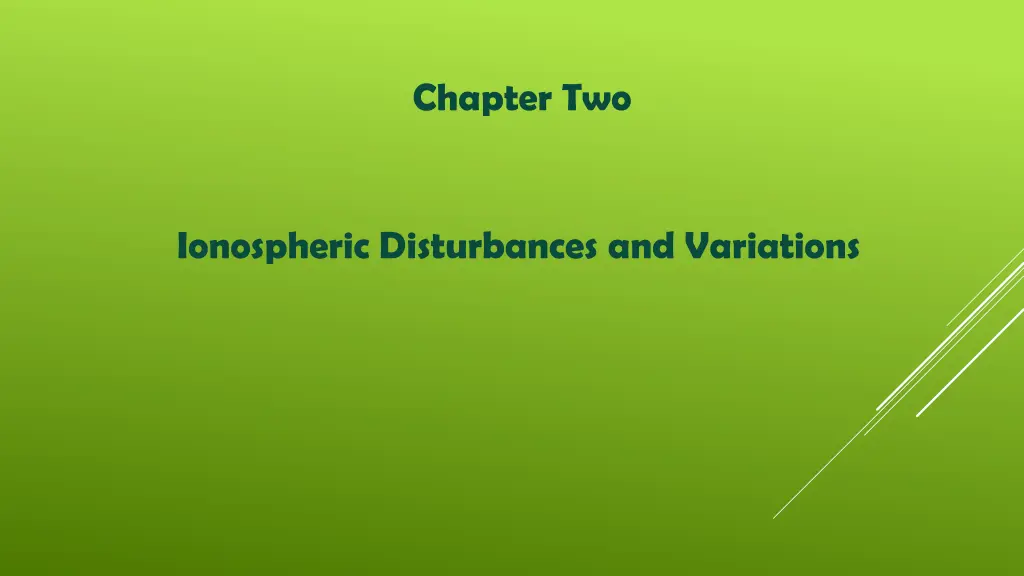
Understanding Ionospheric Disturbances and Variations
Explore the complexities of ionospheric variations affecting communication links, including solar cycle fluctuations, seasonal anomalies, and latitude-dependent frequency variations. Learn how radio frequencies interact with the ionosphere, impacting communication capabilities throughout different times of the year and at varying geographical locations.
Uploaded on | 0 Views
Download Presentation

Please find below an Image/Link to download the presentation.
The content on the website is provided AS IS for your information and personal use only. It may not be sold, licensed, or shared on other websites without obtaining consent from the author. If you encounter any issues during the download, it is possible that the publisher has removed the file from their server.
You are allowed to download the files provided on this website for personal or commercial use, subject to the condition that they are used lawfully. All files are the property of their respective owners.
The content on the website is provided AS IS for your information and personal use only. It may not be sold, licensed, or shared on other websites without obtaining consent from the author.
E N D
Presentation Transcript
Chapter Two Ionospheric Disturbances and Variations
1.Ionospheric Variations Introduction The ionosphere is not a stable medium, this will not allow the use of single radio frequency over the year, or even over 24 hours to setup a successful communication link. The ionosphere varies with the solar cycle, the seasons, the geographical location and during any given day. A frequency, which may provide successful propagation now, may not do so at an hour later.
Among the important ionospheric variations, which affect the properties of the ionosphere and its capable for communication between two location on the Earth's surface are the following: 1. Solar Cycle Variations The Sun goes through a periodic rise and fall in activity which affects HF communications; Solar cycles vary in length from 9 to 14 years. At solar minimum activity, only the lower frequencies of the HF band supported by the ionosphere, while at solar maximum activity the higher frequencies will successfully propagate.
This is because there is more radiation emitted from the Sun at solar maximum activity period; the radiation produces more electrons in the ionosphere, which allows the use of higher frequencies. Figure (7) solar cycle dependence of E and F region frequencies.
2. Seasonal Variations The plasma frequencies are greater in summer than winter for E- region. The variation in F-region frequencies is more complicated. In both hemispheres, the frequency value of F-region at noon show general peak around the equinoxes (March and September). Around solar minimum activity the summer noon frequencies are generally greater than those in winter, but around solar maximum, winter frequencies at certain locations, can be higher than those in summer. In addition, frequencies around the equinoxes are higher than those in summer or winter for both solar maximum and minimum.
The observation of noon, winter frequencies often being greater than those in summer is called the seasonal anomaly. 3. Variations due to the Latitude Figure (8) indicates the variations in E-region and F-region frequencies at noon and midnight from the poles to the geomagnetic equator. During the day and with increasing latitude, solar radiation strikes the atmosphere more obliquely, so the intensity of radiation and the electron density production decreases towards the poles. The daytime F-region frequencies have peak not at the magnetic equator, but around 15-20 degrees north and south of it.
This called the equatorial anomaly. At night, the plasma frequency reach a minimum around 60 degrees latitude north and south of the geomagnetic equator. This is called mid- latitude trough. Figure latitudinal variations. (8) Representation of
1. Diurnal Variations Operating frequencies are normally higher during the day and lower at night. With dawn, solar radiation causes electrons to be produced in the ionosphere and frequencies increase reaching their maximum around noon. During the afternoon, frequencies being decreasing due to electron loss and with evening, the D, E and F regions become insignificant. Therefore, the HF sky wave communication during the night is due to the F-region and absorption of radio waves decreases because of the lack of the D-region. Through the night, plasma frequencies decreases reaching their minimum just before dawn. The typical diurnal variation illustrated in Figure (9).






















